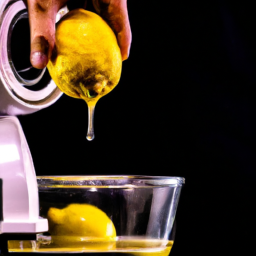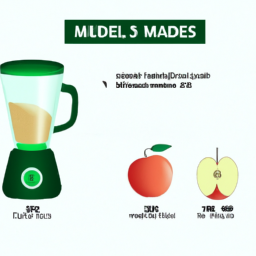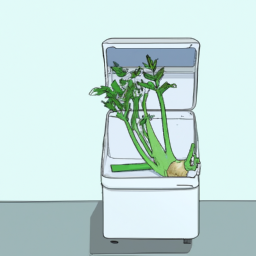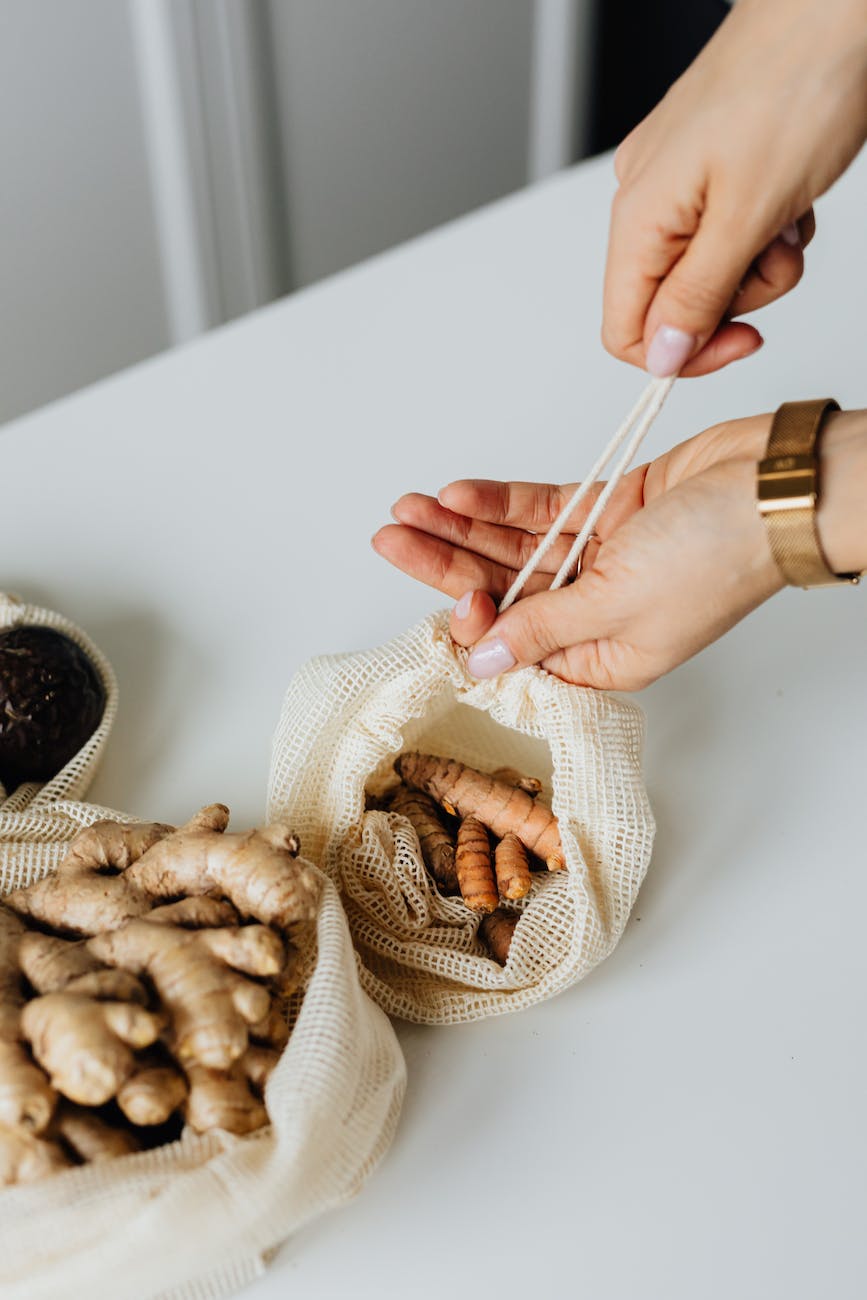Lemons represent freshness and vitality. Just seeing them can boost your mood and awaken your senses. What could be better than using an electric juicer to extract their tangy flavor? As a passionate juicing enthusiast, I am excited to share my tips on the most effective way to juice lemons with an electric juicer.
Using an electric juicer is not only convenient but also a great way to extract the maximum amount of juice from your lemons. Whether you’re making lemonade, salad dressings, or marinades, having freshly squeezed lemon juice can make all the difference in the taste of your dishes.
So, let’s get started on how to use an electric juicer to juice lemons and enjoy a burst of citrusy goodness.
Key Takeaways
- Choosing ripe and blemish-free lemons can maximize juice yield
- Proper assembly and maintenance of electric juicer can ensure longevity
- Glass containers with airtight lids are ideal for storing and preserving lemon juice
- Freshly squeezed lemon juice can enhance the taste of various dishes and act as a natural preservative for fruits and vegetables.
Why Use an Electric Juicer?
You’ll want to use an electric juicer because it saves time and effort, allowing you to enjoy freshly squeezed lemon juice without the hassle. The advantages of using an electric juicer are plenty.
It not only saves you time and effort but also ensures that you get every last drop of juice out of your lemons. The process is straightforward and simple – all you have to do is cut the lemons in half and place them in the juicer. The machine does the rest, leaving you with a refreshing glass of lemon juice in no time.
Another advantage of using an electric juicer is cost-effectiveness. Instead of buying pre-squeezed lemon juice from the store, you can now squeeze your own at home. This will save you money in the long run and ensure that you have fresh lemon juice whenever you need it.
Now that you know why using an electric juicer is the way to go, it’s time to gather your ingredients and get started.
Gather Your Ingredients
So, now that I’ve got my electric juicer ready, it’s time to gather the ingredients to make the perfect lemon juice.
First things first, I need to choose the right lemons. I always look for lemons that are bright yellow, plump, and heavy for their size.
Once I’ve got the right lemons, I make sure to wash them thoroughly before preparing them for juicing.
Choosing the Right Lemons
When picking out your lemons, make sure they’re bright yellow and slightly soft. Lemon varieties like Meyer and Lisbon are great for juicing, but any kind will work. It’s important to choose ripe lemons because they yield more juice. Ripe lemons are slightly soft with thin skin, while unripe lemons are hard with thick skin.
To get the most juice, choose lemons free of blemishes and bruises. Imperfections can affect the amount of juice the lemon produces. Avoid lemons that are too large or small because they may not be as juicy as medium-sized lemons.
By choosing the right lemons, you ensure a flavorful and refreshing glass of lemon juice. Now that you’ve picked your lemons, it’s time to prepare them for juicing.
Preparing Your Lemons
To get your lemons ready for squeezing, start by washing them under cool water and gently patting them dry. This will help remove any dirt or residue that might be on the skin of the lemon.
Once your lemons are clean, roll them on a hard surface, like a countertop, with the palm of your hand to help soften the flesh and make it easier to extract the juice.
When it comes to juicing techniques, there are a few lemon preparation tips that can make the process easier and more efficient. If you’re juicing by hand, cut your lemons in half and use a citrus reamer or juicer to extract the juice. For an electric juicer, you can cut your lemons into quarters or eighths, depending on the size of your juicer’s feed tube.
With your lemons prepped and ready to go, it’s time to move on to preparing your electric juicer.
Prepare Your Electric Juicer
Now that I’ve got my lemons ready, it’s time to prepare my electric juicer.
Assembling the juicer is the first step. It’s important to make sure all the parts are securely in place before starting.
Once the juicing is done, cleaning and maintenance are also crucial. This ensures the longevity of the machine.
Assembling Your Juicer
First things first, you gotta put together your juicer before you can start squeezing those lemons. Make sure to have all the tools needed, including a screwdriver if required. Safety precautions should also be observed, such as unplugging the juicer before assembly and keeping your hands away from any moving parts.
Refer to the instruction manual to assemble your juicer properly. The manual will guide you through the process, from attaching the motor base to the juicing cone. Take your time and ensure each part is secure before moving on to the next step.
Once your electric juicer is assembled, you can move on to juicing those lemons!
Now that your juicer is assembled and ready to go, it’s important to know how to clean and maintain it properly.
Cleaning and Maintenance
Don’t forget to regularly clean and maintain your machine to ensure it stays in good condition and lasts longer. Effective cleaning is key to removing any leftover pulp or seeds that may have stuck to the juicing components.
To do this, disassemble the machine and wash each part in warm soapy water. Use a soft-bristled brush to scrub away any debris that may have accumulated on the blades or mesh strainer. Rinse each part thoroughly and dry them with a clean cloth before reassembling the juicer.
Preventing rust is also an important part of maintaining your electric juicer. After washing and drying each component, apply a light coat of vegetable oil to the blades and other metal parts to prevent oxidation. This will keep your juicer working smoothly and prevent rust from forming.
With proper care and maintenance, your electric juicer will continue to produce delicious and nutritious juice for years to come.
Now that your juicer is clean and ready to go, it’s time to cut your lemons.
Cut Your Lemons
Simply slice your lemons in half and let the juicer work its magic. Before you start cutting, it’s important to choose the right knife for the job. I recommend using a sharp paring knife or a serrated citrus knife for the cleanest cuts. Be sure to avoid using a dull knife, as it can crush the lemon and make it harder to extract the juice.
It’s also important to consider the storage of your lemons before juicing them. Keep them in a cool, dry place or in the refrigerator to ensure they stay fresh and juicy. Using fresh lemons will not only yield more juice, but it will also result in a brighter, more flavorful juice. With these tips in mind, you’re ready to move on to the next step: loading your electric juicer.
Load Your Electric Juicer
Now it’s time to get that sweet, tangy goodness flowing into your glass – all you need to do is load up your handy dandy juicer.
Before you start juicing, make sure to wash your lemons thoroughly. You can also juice other citrus fruits like oranges and grapefruits in your electric juicer.
When loading your juicer, cut your lemons into quarters and remove any seeds that may be present. Place the quarters into the feeding chute and press down with the plunger to extract the juice. It’s important to note that you shouldn’t overload your juicer, as this can cause the machine to jam or not function properly.
Now that your juicer is loaded with lemons, it’s time to juice those babies and get that delicious citrus flavor.
Juice Your Lemons
To get the most out of your citrus fruits, imagine that you’re squeezing every last drop out of a sponge as you press down with the plunger in your handy dandy juice extractor.
For lemons, it’s important to cut off both ends of the fruit before slicing it in half. You can then place the lemon halves face down on the juicing cone and press down with the plunger. Alternatively, you can cut the lemon into smaller pieces and place them in the feeding tube of the juicer. This method may be more efficient if you have a lot of lemons to juice.
There are different lemon juicing techniques you can try to get more juice out of each fruit. Some people recommend microwaving the lemons for a few seconds to soften them before juicing. Others suggest rolling the lemons on a hard surface with your palm to help release the juice.
Once you’ve juiced your lemons, you can use the juice for a variety of purposes. Lemon juice can be added to drinks, used as a marinade for meat, or to add flavor to sauces and dressings.
To collect your juice, you can either use the juice container that came with your electric juicer or place a glass underneath the spout. Keep in mind that freshly squeezed lemon juice should be used immediately or refrigerated for later use.
Now that you know how to juice lemons in an electric juicer, let’s move on to the next step: collecting your juice.
Collect Your Juice
After extracting the citrus juice, the next step is to find a suitable container to store it in. Here are some storing tips for preserving freshness:
-
Use a glass container: Plastic or metal containers can react with the acidity of the juice, altering its taste and quality.
-
Seal the container: Air exposure can cause the juice to spoil quickly, so make sure to use an airtight lid or cover on the container.
-
Refrigerate immediately: Freshly squeezed lemon juice can last up to a week in the fridge, but it’s essential to store it in the refrigerator as soon as possible.
-
Label the container: To avoid confusion, label the container with the date of extraction and the type of citrus juice to help you keep track of its freshness.
By following these tips, you can ensure that your lemon juice stays fresh and delicious for as long as possible.
Now it’s time to strain your juice to remove any pulp or seeds that may have been left behind during the juicing process.
Strain Your Juice
Now that I’ve collected my lemon juice, the next step is to strain it.
To ensure that my juice is free of pulp and seeds, I need to choose the right strainer. There are different types of strainers available, and I’ll discuss the best ones to use and the various straining techniques that can be employed to get the best results.
Choosing the Right Strainer
Picking the perfect strainer for your electric juicer is crucial for achieving the perfect consistency and taste in your lemon juice. There are various types of strainers to choose from, each with their unique features and benefits. Some of the most common types of strainers include mesh strainers, cheesecloth, and fine-mesh sieves. Mesh strainers are perfect for straining out large pulp and seeds, while cheesecloth is ideal for straining small particles and creating a smooth texture. Fine-mesh sieves are perfect for creating a velvety texture in your lemon juice.
When choosing the right strainer for your electric juicer, it’s essential to consider the size of the pulp and seeds that you want to remove. You also want to ensure that the strainer fits securely over the juicer’s cup to avoid any spills or messes. Additionally, it’s essential to handle the strainer gently when straining your lemon juice to prevent any breakage or damage. With the right strainer, you can easily achieve the perfect consistency and taste in your lemon juice, making it a refreshing and delicious beverage.
To ensure that your lemon juice is free from impurities and has a smooth texture, it’s crucial to master the art of straining. In the next section, we’ll explore some straining techniques that will help you achieve the perfect lemon juice every time.
Straining Techniques
To achieve the perfect consistency and taste in your lemon drink, you’ll need to master the art of straining with various techniques that suit your preferences.
There are several straining alternatives that you can use, depending on the texture and pulpiness you desire. For instance, you could use a fine mesh strainer to remove all the pulp and seeds from the juice, or a cheesecloth if you want a slightly pulpy texture. Additionally, you could use a nut-milk bag or a coffee filter if you prefer a thicker texture.
When choosing the best straining tools, consider the size and thickness of the mesh, the material used, and the ease of cleaning. A stainless steel strainer is preferable since it’s sturdy, durable, and easy to clean. Also, ensure that the mesh size is small enough to filter out the tiny seeds and pulp, but not too tiny to prevent the juice from passing through.
Lastly, clean the strainer immediately after use to avoid any clogging of pulp or discoloration of the mesh.
Next up, we’ll discuss how to clean your electric juicer to maintain its efficiency and prolong its lifespan.
Clean Your Electric Juicer
If you’re using an electric juicer, make sure to clean it thoroughly after each use to avoid buildup and maintain its functionality. Effective cleaning and maintenance tips are important to keep your juicer working efficiently for a long time. Here are three important things to keep in mind when cleaning your electric juicer:
-
Disassemble the juicer and rinse all of the parts separately with warm soapy water. Avoid using abrasive sponges or harsh chemicals that could damage the juicer parts.
-
Pay special attention to the mesh strainer and the blade as these are the areas where pulp and seeds tend to accumulate. Use a small brush or toothbrush to gently scrub these areas and remove any buildup.
-
Once all the parts are clean and dry, reassemble the juicer and store it in a safe place. Troubleshooting common issues such as clogging or uneven juicing can often be avoided by following proper cleaning and maintenance practices.
Now that your electric juicer is clean and ready to use, it’s time to enjoy your fresh lemon juice.
Enjoy Your Fresh Lemon Juice
Savoring the zesty aroma and tart flavor of freshly squeezed lemon is like taking a refreshing sip of sunshine on a hot summer day. Once you’ve successfully juiced your lemons using an electric juicer, there are countless ways to enjoy your fresh lemon juice.
One of the most popular uses for fresh lemon juice is to make lemonade, a classic summer beverage that’s perfect for quenching your thirst on a hot day. Simply mix the lemon juice with water and sugar to taste, and you have a delicious drink that everyone will love.
In addition to lemonade, there are many other recipes that call for fresh lemon juice. Lemon juice can be used to add flavor to salad dressings, marinades, and sauces. It can also be used as a natural preservative for fruits and vegetables, preventing them from turning brown.
For a quick and easy snack, sprinkle a little lemon juice over sliced fruits like apples or pears to add a tangy flavor. With so many uses for fresh lemon juice, there’s no reason not to enjoy the delicious flavor and health benefits of this versatile citrus fruit.
Frequently Asked Questions
What types of electric juicers are best for juicing lemons?
Based on my experience, electric juicers with a cone-shaped reamer and adjustable pulp control feature work best for juicing lemons. Brands like Breville and Cuisinart offer reliable options for lemon juicing.
Can electric juicers be used to juice other citrus fruits besides lemons?
Electric juicers are great for all citrus fruits, not just lemons. The benefits include time and energy savings, and a higher yield of juice. To clean, disassemble and wash each part thoroughly with soap and water.
How many lemons should be used to make a certain amount of lemon juice?
To make lemon juice, the ratio is typically 4-6 lemons per cup. Different types of electric juicers can be used to juice lemons and other citrus fruits, but it’s important to follow the manufacturer’s instructions for best results.
How long can fresh lemon juice be stored in the fridge?
I could drink fresh lemon juice all day, but realistically, it’s best to store it in the fridge for up to a week. Use leftover juice for salad dressings or marinades. If it smells off or tastes funny, it’s gone bad.
Are there any tips for getting the most juice out of each lemon when using an electric juicer?
To maximize yield, proper preparation is key when using an electric juicer. Roll the lemon firmly on a hard surface before cutting and juicing. This will help release the juices and result in more juice.
Conclusion
Well, that’s it! You’ve successfully juiced your lemons using an electric juicer.
But wait, there’s more. Don’t you want to taste that freshly squeezed lemon juice in all its glory? Imagine the tangy, zesty aroma filling up your kitchen as you pour the juice into a glass. You take a sip and feel the sourness mixed with a hint of sweetness, making your taste buds dance with pleasure.
Now, imagine using that juice to make lemonade, lemon meringue pie, or even a lemon vinaigrette for your salad. The possibilities are endless.
So go ahead, give it a try, and see what delicious creations you can come up with using your freshly squeezed lemon juice. Cheers to a refreshing and satisfying drink!
Ilana has been a vegan for over 10 years. She originally made the switch for health reasons, but soon found herself becoming more and more passionate about the ethical and environmental implications of a vegan lifestyle. Ilana is the author of The Graceful Kitchen, a blog all about veganism. She loves to cook up delicious and nutritious vegan meals, and share her recipes with others who are interested in leading a cruelty-free life. Ilana is also a strong advocate for using whole foods as the foundation of a healthy diet, and believes that going vegan is one of the best ways to achieve this.










